Page 25 of 95
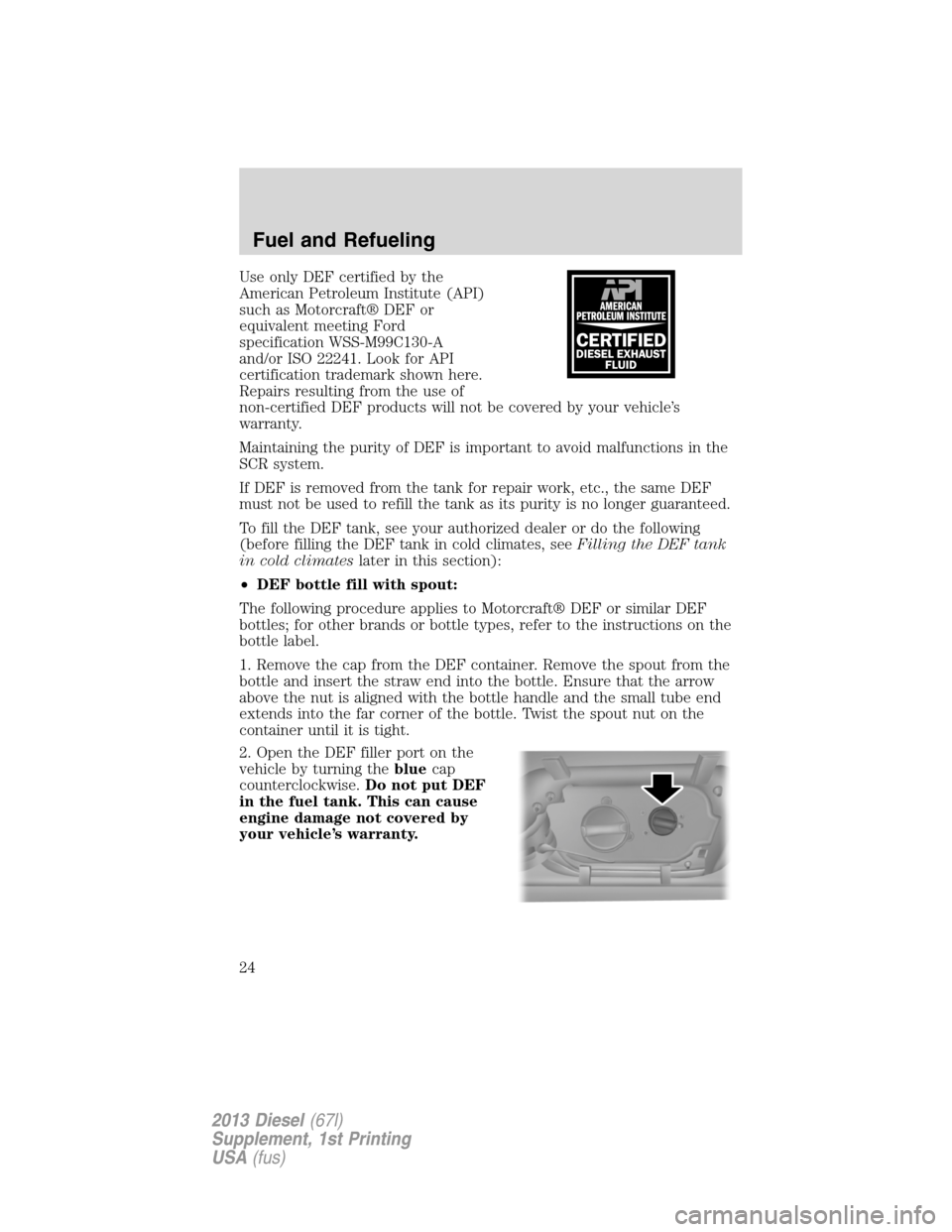
Use only DEF certified by the
American Petroleum Institute (API)
such as Motorcraft® DEF or
equivalent meeting Ford
specification WSS-M99C130-A
and/or ISO 22241. Look for API
certification trademark shown here.
Repairs resulting from the use of
non-certified DEF products will not be covered by your vehicle’s
warranty.
Maintaining the purity of DEF is important to avoid malfunctions in the
SCR system.
If DEF is removed from the tank for repair work, etc., the same DEF
must not be used to refill the tank as its purity is no longer guaranteed.
To fill the DEF tank, see your authorized dealer or do the following
(before filling the DEF tank in cold climates, seeFilling the DEF tank
in cold climateslater in this section):
•DEF bottle fill with spout:
The following procedure applies to Motorcraft® DEF or similar DEF
bottles; for other brands or bottle types, refer to the instructions on the
bottle label.
1. Remove the cap from the DEF container. Remove the spout from the
bottle and insert the straw end into the bottle. Ensure that the arrow
above the nut is aligned with the bottle handle and the small tube end
extends into the far corner of the bottle. Twist the spout nut on the
container until it is tight.
2. Open the DEF filler port on the
vehicle by turning thebluecap
counterclockwise.Do not put DEF
in the fuel tank. This can cause
engine damage not covered by
your vehicle’s warranty.
Fuel and Refueling
24
2013 Diesel(67l)
Supplement, 1st Printing
USA(fus)
Page 26 of 95
3. Lift and hold the DEF container,
without tipping, and insert the spout
into the DEF filler port until the
small black seal on the spout is
completely seated into the DEF
filler port.
4A. While filling, the fluid level in
the bottle will continually drop.
4B. When the DEF tank is full, the
fluid level in the bottle will stop
dropping, indicating the fluid has
stopped flowing.
Fuel and Refueling
25
2013 Diesel(67l)
Supplement, 1st Printing
USA(fus)
Page 27 of 95
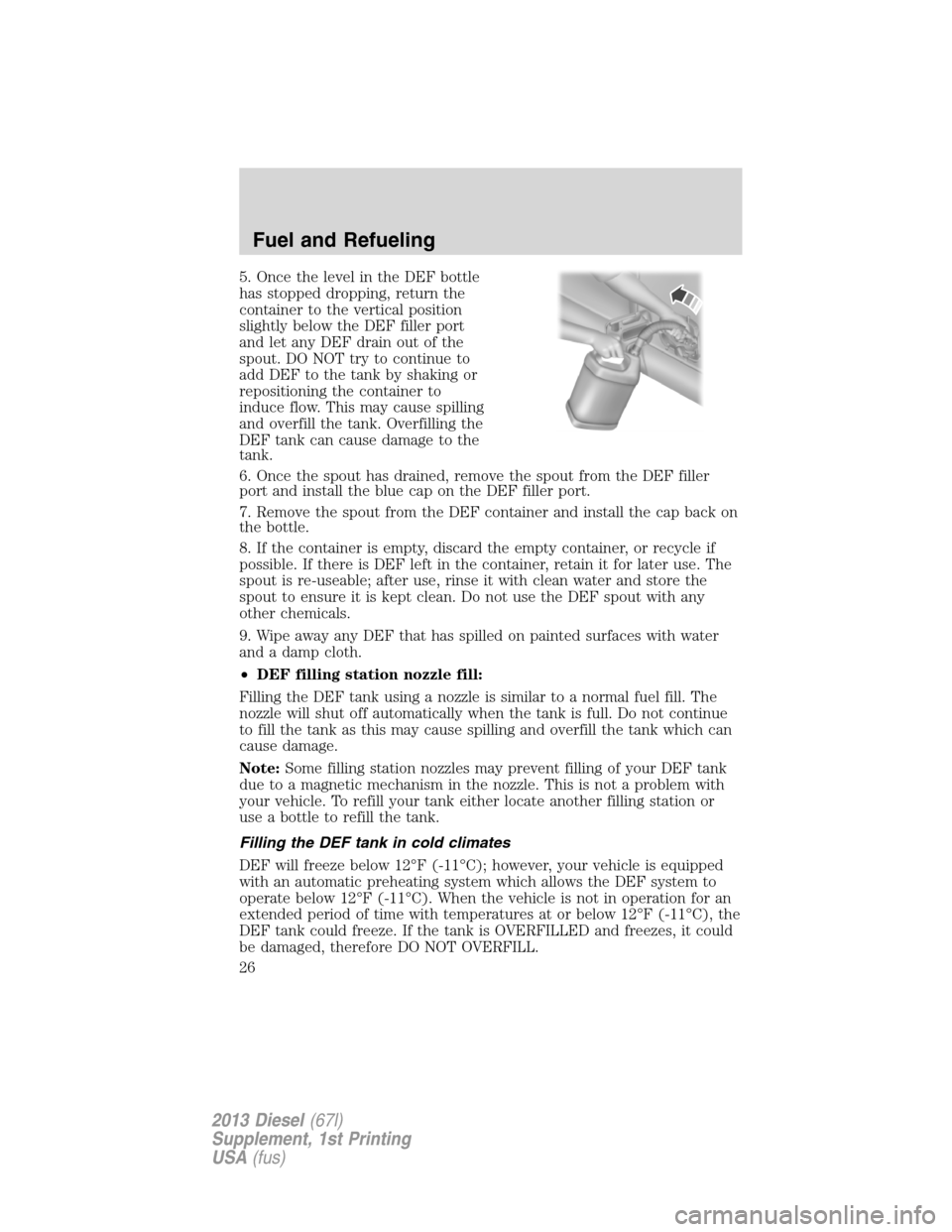
5. Once the level in the DEF bottle
has stopped dropping, return the
container to the vertical position
slightly below the DEF filler port
and let any DEF drain out of the
spout. DO NOT try to continue to
add DEF to the tank by shaking or
repositioning the container to
induce flow. This may cause spilling
and overfill the tank. Overfilling the
DEF tank can cause damage to the
tank.
6. Once the spout has drained, remove the spout from the DEF filler
port and install the blue cap on the DEF filler port.
7. Remove the spout from the DEF container and install the cap back on
the bottle.
8. If the container is empty, discard the empty container, or recycle if
possible. If there is DEF left in the container, retain it for later use. The
spout is re-useable; after use, rinse it with clean water and store the
spout to ensure it is kept clean. Do not use the DEF spout with any
other chemicals.
9. Wipe away any DEF that has spilled on painted surfaces with water
and a damp cloth.
•DEF filling station nozzle fill:
Filling the DEF tank using a nozzle is similar to a normal fuel fill. The
nozzle will shut off automatically when the tank is full. Do not continue
to fill the tank as this may cause spilling and overfill the tank which can
cause damage.
Note:Some filling station nozzles may prevent filling of your DEF tank
due to a magnetic mechanism in the nozzle. This is not a problem with
your vehicle. To refill your tank either locate another filling station or
use a bottle to refill the tank.
Filling the DEF tank in cold climates
DEF will freeze below 12°F (-11°C); however, your vehicle is equipped
with an automatic preheating system which allows the DEF system to
operate below 12°F (-11°C). When the vehicle is not in operation for an
extended period of time with temperatures at or below 12°F (-11°C), the
DEF tank could freeze. If the tank is OVERFILLED and freezes, it could
be damaged, therefore DO NOT OVERFILL.
Fuel and Refueling
26
2013 Diesel(67l)
Supplement, 1st Printing
USA(fus)
Page 28 of 95
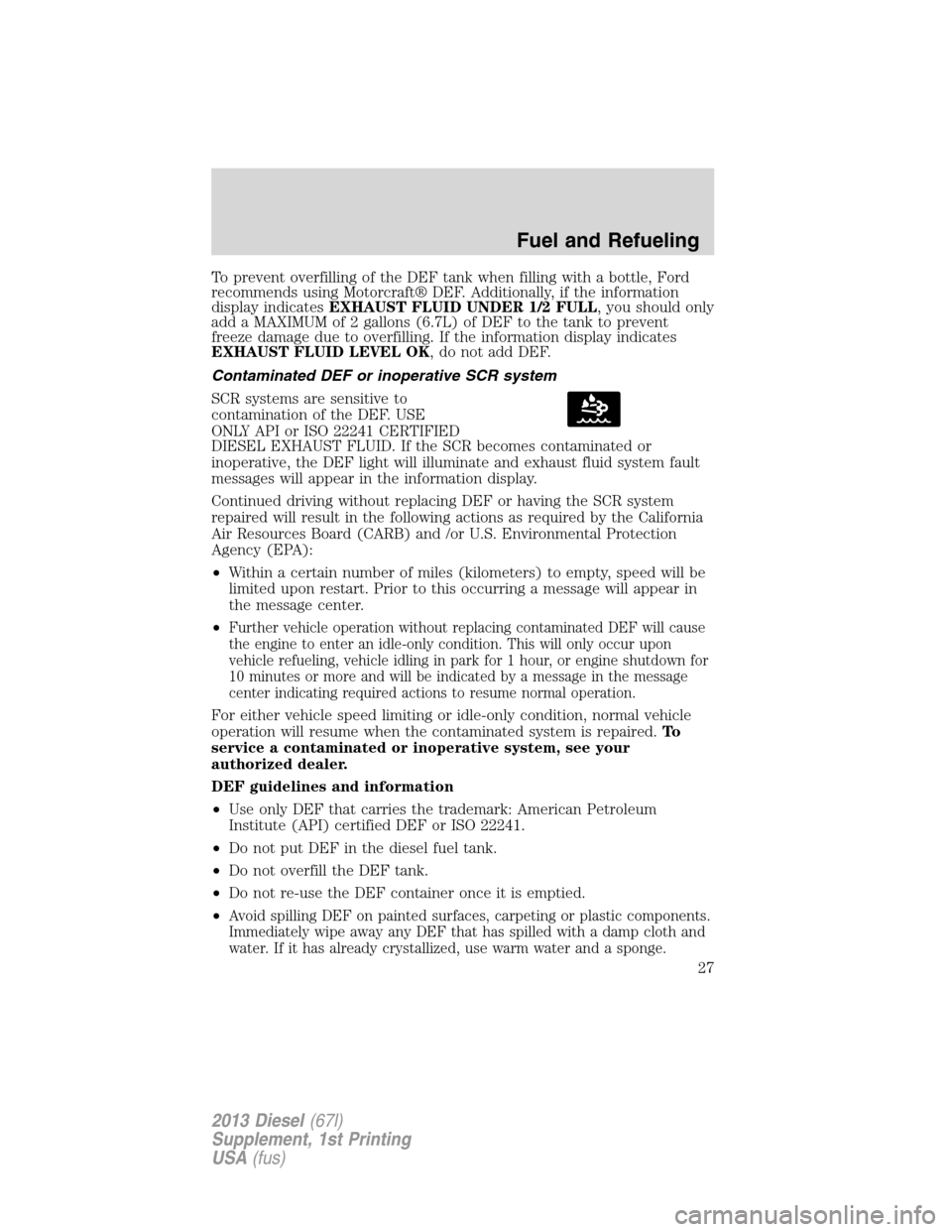
To prevent overfilling of the DEF tank when filling with a bottle, Ford
recommends using Motorcraft® DEF. Additionally, if the information
display indicatesEXHAUST FLUID UNDER 1/2 FULL, you should only
add a MAXIMUM of 2 gallons (6.7L) of DEF to the tank to prevent
freeze damage due to overfilling. If the information display indicates
EXHAUST FLUID LEVEL OK, do not add DEF.
Contaminated DEF or inoperative SCR system
SCR systems are sensitive to
contamination of the DEF. USE
ONLY API or ISO 22241 CERTIFIED
DIESEL EXHAUST FLUID. If the SCR becomes contaminated or
inoperative, the DEF light will illuminate and exhaust fluid system fault
messages will appear in the information display.
Continued driving without replacing DEF or having the SCR system
repaired will result in the following actions as required by the California
Air Resources Board (CARB) and /or U.S. Environmental Protection
Agency (EPA):
•Within a certain number of miles (kilometers) to empty, speed will be
limited upon restart. Prior to this occurring a message will appear in
the message center.
•
Further vehicle operation without replacing contaminated DEF will cause
the engine to enter an idle-only condition. This will only occur upon
vehicle refueling, vehicle idling in park for 1 hour, or engine shutdown for
10 minutes or more and will be indicated by a message in the message
center indicating required actions to resume normal operation.
For either vehicle speed limiting or idle-only condition, normal vehicle
operation will resume when the contaminated system is repaired.To
service a contaminated or inoperative system, see your
authorized dealer.
DEF guidelines and information
•Use only DEF that carries the trademark: American Petroleum
Institute (API) certified DEF or ISO 22241.
•Do not put DEF in the diesel fuel tank.
•Do not overfill the DEF tank.
•Do not re-use the DEF container once it is emptied.
•
Avoid spilling DEF on painted surfaces, carpeting or plastic components.
Immediately wipe away any DEF that has spilled with a damp cloth and
water. If it has already crystallized, use warm water and a sponge.
Fuel and Refueling
27
2013 Diesel(67l)
Supplement, 1st Printing
USA(fus)
Page 29 of 95
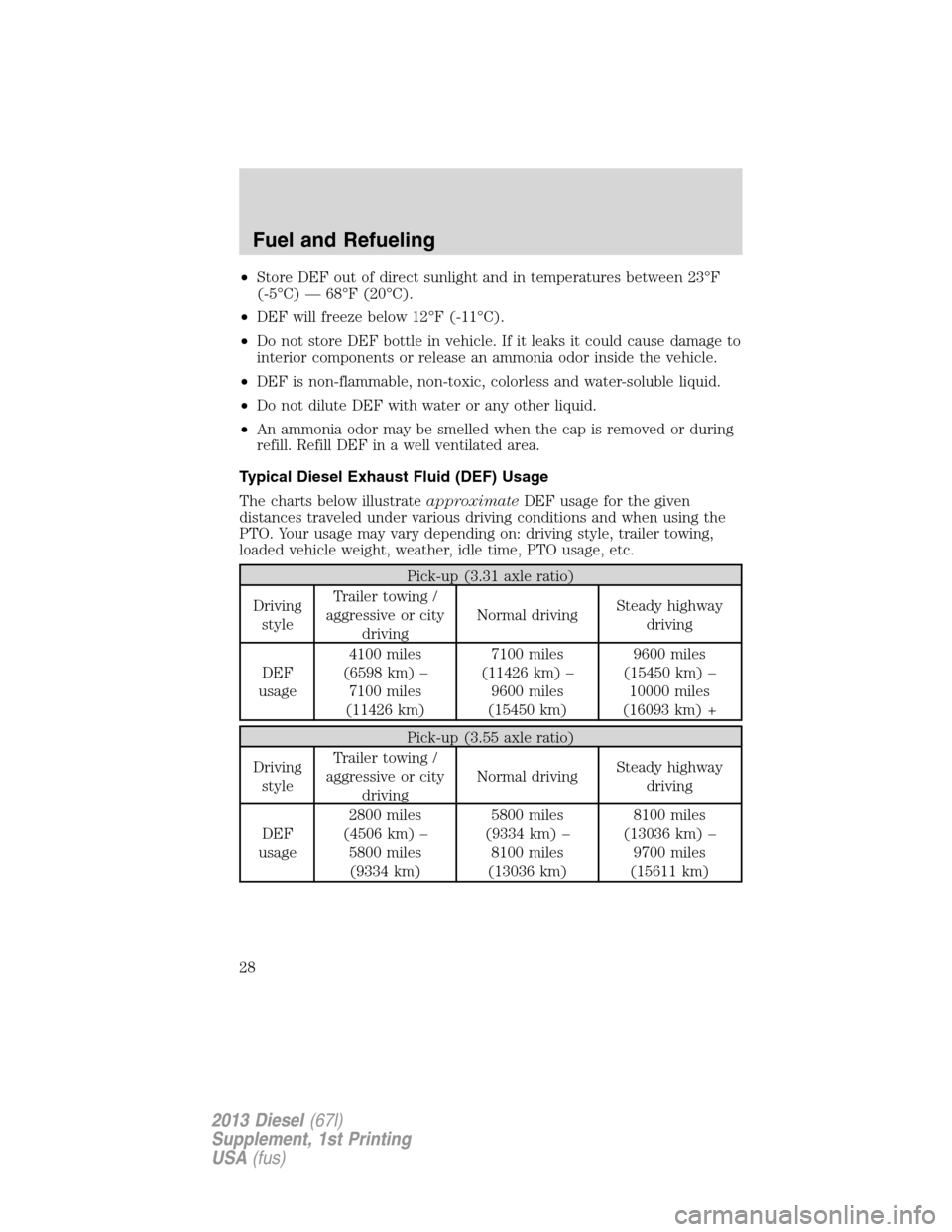
•Store DEF out of direct sunlight and in temperatures between 23°F
(-5°C) — 68°F (20°C).
•DEF will freeze below 12°F (-11°C).
•Do not store DEF bottle in vehicle. If it leaks it could cause damage to
interior components or release an ammonia odor inside the vehicle.
•DEF is non-flammable, non-toxic, colorless and water-soluble liquid.
•Do not dilute DEF with water or any other liquid.
•An ammonia odor may be smelled when the cap is removed or during
refill. Refill DEF in a well ventilated area.
Typical Diesel Exhaust Fluid (DEF) Usage
The charts below illustrateapproximateDEF usage for the given
distances traveled under various driving conditions and when using the
PTO. Your usage may vary depending on: driving style, trailer towing,
loaded vehicle weight, weather, idle time, PTO usage, etc.
Pick-up (3.31 axle ratio)
Driving
styleTrailer towing /
aggressive or city
drivingNormal drivingSteady highway
driving
DEF
usage4100 miles
(6598 km) –
7100 miles
(11426 km)7100 miles
(11426 km) –
9600 miles
(15450 km)9600 miles
(15450 km) –
10000 miles
(16093 km) +
Pick-up (3.55 axle ratio)
Driving
styleTrailer towing /
aggressive or city
drivingNormal drivingSteady highway
driving
DEF
usage2800 miles
(4506 km) –
5800 miles
(9334 km)5800 miles
(9334 km) –
8100 miles
(13036 km)8100 miles
(13036 km) –
9700 miles
(15611 km)
Fuel and Refueling
28
2013 Diesel(67l)
Supplement, 1st Printing
USA(fus)
Page 30 of 95
Pick-up (3.73 axle ratio)
Driving
styleTrailer towing /
aggressive or city
drivingNormal drivingSteady highway
driving
DEF
usage2050 miles
(3299 km) –
5050 miles
(8127 km)5050 miles
(8127 km) –
7300 miles
(11748 km)7300 miles
(11748 km) –
8900 miles
(14323 km)
Pick-up (4.30 axle ratio)
Driving
styleTrailer towing /
aggressive or city
drivingNormal drivingSteady highway
driving
DEF
usage1100 miles
(1770 km) –
4100 miles
(6598 km)4100 miles
(6598 km) –
6300 miles
(10139 km)6300 miles
(10139 km) –
7900 miles
(12714 km)
Chassis cab (non–PTO)
Driving
styleTrailer towing /
aggressive or city
drivingNormal drivingSteady highway
driving
DEF
usage1700 miles
(2736 km) –
4700 miles
(7564 km)4700 miles
(7564 km) –
7800 miles
(12553 km)7800 miles
(12553 km) –
9300 miles
(14967 km)
Chassis cab (with PTO)
PTO
usage<---Cont. PTO usage — Min. PTO usage--->
DEF
usage0 miles (0 km) — 7800 miles (12553 km)
Fuel and Refueling
29
2013 Diesel(67l)
Supplement, 1st Printing
USA(fus)
Page 31 of 95
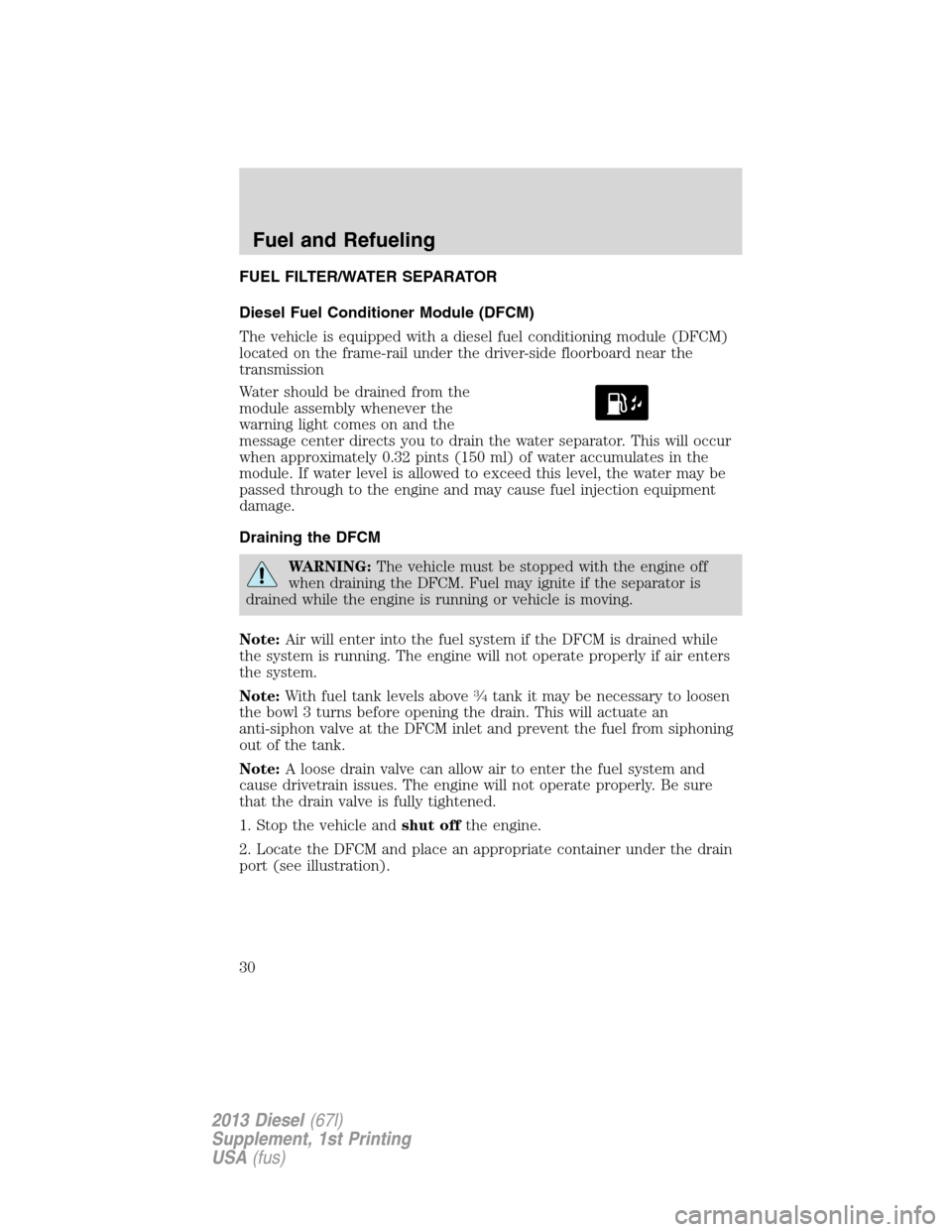
FUEL FILTER/WATER SEPARATOR
Diesel Fuel Conditioner Module (DFCM)
The vehicle is equipped with a diesel fuel conditioning module (DFCM)
located on the frame-rail under the driver-side floorboard near the
transmission
Water should be drained from the
module assembly whenever the
warning light comes on and the
message center directs you to drain the water separator. This will occur
when approximately 0.32 pints (150 ml) of water accumulates in the
module. If water level is allowed to exceed this level, the water may be
passed through to the engine and may cause fuel injection equipment
damage.
Draining the DFCM
WARNING:The vehicle must be stopped with the engine off
when draining the DFCM. Fuel may ignite if the separator is
drained while the engine is running or vehicle is moving.
Note:Air will enter into the fuel system if the DFCM is drained while
the system is running. The engine will not operate properly if air enters
the system.
Note:With fuel tank levels above
3�4tank it may be necessary to loosen
the bowl 3 turns before opening the drain. This will actuate an
anti-siphon valve at the DFCM inlet and prevent the fuel from siphoning
out of the tank.
Note:A loose drain valve can allow air to enter the fuel system and
cause drivetrain issues. The engine will not operate properly. Be sure
that the drain valve is fully tightened.
1. Stop the vehicle andshut offthe engine.
2. Locate the DFCM and place an appropriate container under the drain
port (see illustration).
Fuel and Refueling
30
2013 Diesel(67l)
Supplement, 1st Printing
USA(fus)
Page 32 of 95
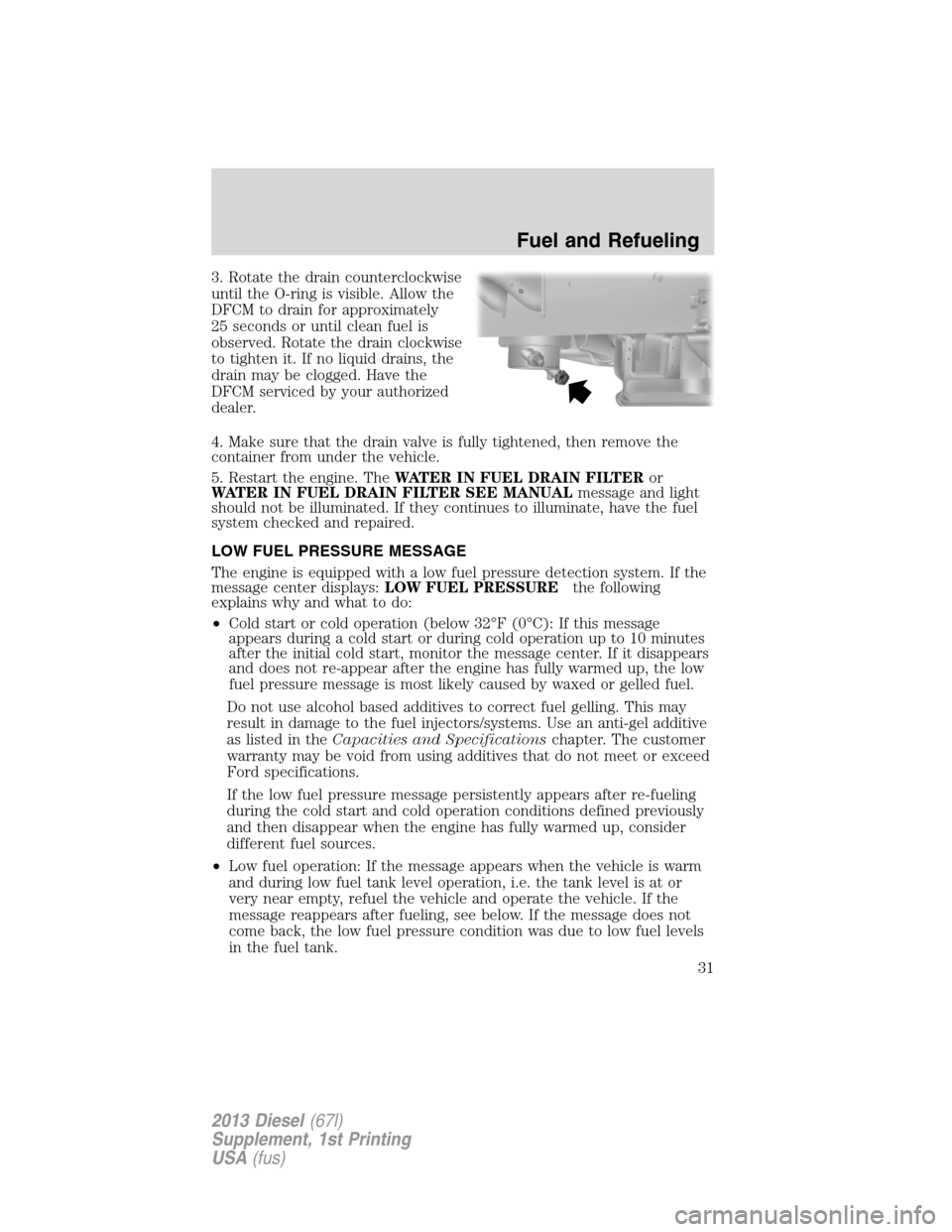
3. Rotate the drain counterclockwise
until the O-ring is visible. Allow the
DFCM to drain for approximately
25 seconds or until clean fuel is
observed. Rotate the drain clockwise
to tighten it. If no liquid drains, the
drain may be clogged. Have the
DFCM serviced by your authorized
dealer.
4. Make sure that the drain valve is fully tightened, then remove the
container from under the vehicle.
5. Restart the engine. TheWATER IN FUEL DRAIN FILTERor
WATER IN FUEL DRAIN FILTER SEE MANUALmessage and light
should not be illuminated. If they continues to illuminate, have the fuel
system checked and repaired.
LOW FUEL PRESSURE MESSAGE
The engine is equipped with a low fuel pressure detection system. If the
message center displays:LOW FUEL PRESSUREthe following
explains why and what to do:
•Cold start or cold operation (below 32°F (0°C): If this message
appears during a cold start or during cold operation up to 10 minutes
after the initial cold start, monitor the message center. If it disappears
and does not re-appear after the engine has fully warmed up, the low
fuel pressure message is most likely caused by waxed or gelled fuel.
Do not use alcohol based additives to correct fuel gelling. This may
result in damage to the fuel injectors/systems. Use an anti-gel additive
as listed in theCapacities and Specificationschapter. The customer
warranty may be void from using additives that do not meet or exceed
Ford specifications.
If the low fuel pressure message persistently appears after re-fueling
during the cold start and cold operation conditions defined previously
and then disappear when the engine has fully warmed up, consider
different fuel sources.
•Low fuel operation: If the message appears when the vehicle is warm
and during low fuel tank level operation, i.e. the tank level is at or
very near empty, refuel the vehicle and operate the vehicle. If the
message reappears after fueling, see below. If the message does not
come back, the low fuel pressure condition was due to low fuel levels
in the fuel tank.
Fuel and Refueling
31
2013 Diesel(67l)
Supplement, 1st Printing
USA(fus)